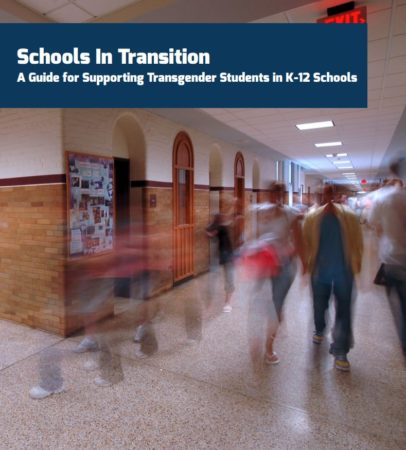Schools are increasingly being called upon to include and support transgender students. Recognizing that this can seem daunting or overwhelming, “Schools In Transition: A Guide for Supporting Transgender in K-12 Schools” offers practical guidance and field-tested tips to parents, educators, administrators, and community members on planning and supporting a transgender student through a transition at school. The guide is geared toward the needs of all students, kindergarten through twelfth grade, and incorporates recommendations that will allow schools to tailor those plans to the particular circumstances of the student and school.
“Schools in Transition” is a unique and crucial resource for educators, caregivers and students. A young person’s assertion of their authentic gender, and the attendant questions it raises can feel overwhelming for all involved,”said Joel Baum, Senior Director of Professional Development and Family Services for Gender Spectrum. “This invaluable tool effectively breaks down the process, helping convert uncertainty to action. It provides a roadmap in which everyone can locate themselves on the journey to a successful experience for all.”
More and more transgender students of all ages are asking their families and communities to support them in living their lives authentically. Having that support in school is critical because of the central role that schools play in their lives. A negative school experience not only hinders a transgender student’s academic achievement and growth, but can also interfere with their long-term mental health. “Schools In Transition” helps prevent that from happening.
The guide includes:
- Information about basic concepts of gender. It is critical that those supporting a transgender or other gender-expansive child understand the complexity of gender.
- The importance of gender identity and the harm society suffers when any students are marginalized at school.
- General guidelines for meeting the needs of transgender students, including intentionality and an awareness of the trade-offs inherent in any decisions about a student’s transition.
- Specific issues affecting transgender youth, including the use of chosen names and pronouns, student confidentiality and student records, restroom and locker room access, sports and other sex-separated activities and harassment or bullying.
- Best practices for working with unsupportive parents or parents who disagree about the appropriate response to their child’s expressed gender identity. It also addresses how special education plans can be used to help transgender students.
- Overview of the legal landscape that administrators, educators, parents and students should be aware of as they work together to create a safe and supportive school environment for all students.

